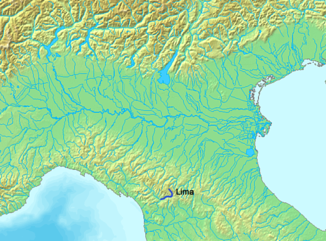Lima (Serchio)
| Lima | ||
|
The course of the Lima |
||
| Data | ||
| location | Pistoia and Lucca provinces , Tuscany , Italy | |
| River system | Serchio | |
| Drain over | Serchio → Ligurian Sea | |
| River basin district | Pilota del Serchio District | |
| source | Abetone parish 44 ° 8 ′ 21 ″ N , 10 ° 41 ′ 26 ″ E |
|
| muzzle |
Bagni di Lucca coordinates: 43 ° 59 ′ 57 " N , 10 ° 33 ′ 13" E 43 ° 59 ′ 57 " N , 10 ° 33 ′ 13" E
|
|
| length | 42 km | |
| Left tributaries | Liesina, Limestre, Volata, Verdiana | |
| Right tributaries | Sestaione | |
|
The Lima just before Bagni di Lucca |
||
The Lima is a 42 km long river ( Torrente ) in Tuscany , which runs through the provinces of Pistoia and Lucca from north to south-west and flows into the Serchio after Bagni di Lucca as the left and most important tributary .
course
The Lima rises in the southeastern part of the municipality of Abetone on the southern slopes of the mountains Corno alle Scale and Libro Aperto in the Montagna Pistoiese mountain range and runs through the municipality of Abetone for a total of 4 km, after which it enters that of Cutigliano . Here it first meets the bridge Ponte Ximeniano (built in 1772 by Leonardo Ximenes) and the districts of Rivoreta at 900 m and Ponte Sestaione (637 m), where the 11 km long tributary Sestaione flows in from the right . After the main town of Cutiglione, where it crosses what is probably the oldest bridge over the Lima (probably rebuilt in 1624), and the bridge at Lizzano Pistoiese (district of San Marcello Pistoiese ), it runs along Strada Statale 12 dell'Abetone e del Brennero to La Lima (450 m), a place that is ascribed to Piteglio on the right side (approx. 140 inhabitants) and on the left side of the river to San Marcello Pistoiese (a total of 6 km of the river as the western municipality boundary) belongs (approx. 25 inhabitants). The 7 km long Torrente Limestre flows from the Limestre district on the left. Between Mammiano (district of San Marcello Pistoiese) and Popiglio (municipality of Piteglio) the river crosses the suspension bridge Ponte sospeso di San Marcello Pistoiese (also called Ponte Sospeso delle Ferriere ), which was built between 1920 and 1922 by Vincenzo Douglas Scotti and 212.4 Meters long. This makes it one of the longest suspension bridges in the world. The Lima remains 8 km in the municipality of Piteglio. Here, after the main town, it passes under the bridge Ponte di Castruccio Castracani (also called Ponte di Campanelle ) near Lolle . The arch bridge was built by Castruccio Castracani at the beginning of the 14th century. After Piteglio the Lima leaves the Province of Pistoia and enters that of Lucca . He spends 21 km in the municipality of Bagni di Lucca and first meets the 14th century Ponte Maggio and then the Giardinetto district , which is 300 m. After Scesta (241 m) and Fabbriche Casabasciana (202 m), it reaches the center of Bagni di Lucca at 150 m. Shortly afterwards, he comes across the Ponte a Serraglio bridge , which was first built as a wooden bridge and was destroyed in the flood of 1836, but was then rebuilt as a stone bridge. In Borgo a Mozzano the river spends 2 km and serves as the municipality's northern border with Bagni di Lucca. Here it enters the Serchio as the left and most important tributary .
photos
literature
- Giorgio Battini: Il fiume racconta. Viaggio nella Toscana dei fiumi. , Bonechi, Florenz 1993, ISBN 88-7009-941-5 , p. 116 ff.
- Emanuele Repetti: LIMA (Lima fiume). In Dizionario Geografico Fisico Storico della Toscana (1833–1846), online edition of the University of Siena (pdf, Italian)
Web links
Individual evidence
- ↑ a b c d e f SIRA
- ↑ a b c d Repetti
- ↑ - ( Memento of the original from October 29, 2013 in the Internet Archive ) Info: The archive link was inserted automatically and has not yet been checked. Please check the original and archive link according to the instructions and then remove this notice. Website Itinerari Lorenesi in Toscana , accessed on 27 October 2013 (Italian) - no longer available
- ↑ a b c Official website of the ISTAT ( Istituto Nazionale di Statistica ) for the districts 2001 in the province of Pistoia, accessed on October 27, 2013 (Italian)
- ↑ Official website of the Sistema Informativo Ambientale della Regione Toscana (SIRA) on Torrente Sestaione , accessed on October 27, 2013 (Italian)
- ↑ Official website of the Sistema Informativo Ambientale della Regione Toscana (SIRA) on Torrente Limestre , accessed on October 27, 2013 (Italian)
- ^ Istituto e Museo di Storia della Scienza IMSS of the Museo Galileo , accessed on October 25, 2013 (Italian)
- ↑ Website Castelli Toscani for Ponte di Castruccio , with illus., Accessed on October 25, 2013 (Italian)
- ^ Website Terre di Lucca e di Versilia zur Ponte Maggio , accessed on October 27, 2013 (Italian)
- ↑ a b c d Official website of the ISTAT ( Istituto Nazionale di Statistica ) for the districts 2001 in the province of Lucca, accessed on October 27, 2013 (Italian)
- ↑ Website Bagni di Lucca Terme to Ponte a Serraglio , accessed on October 27, 2013 (Italian)




